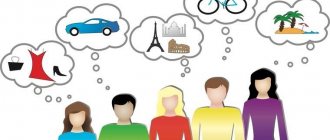The role of needs in human life
Today society cannot imagine its life without household appliances, electronics, mobile phones, computers and the Internet. All these are needs that have emerged relatively recently. Each person has his own number of needs, they can arise due to a feeling of dissatisfaction and deficiency. Needs may change over time, but one thing remains constant: a person will always need something.
With the development of technology, the Internet, and advertising, the needs in human society are increasing. Needs constantly arise again; they cannot be satisfied once and for all. You can’t get enough sleep for the rest of your life, eat, get dressed, and socialize.
The role of needs in human life is very great. It is they who force a person to actively act, to take measures to achieve what he wants. Some needs can be satisfied immediately (eat, drink), while others will take a long time to achieve (buying a new apartment).
All the achievements of modern society, useful things and values would not exist without the increasing role of needs. There would be no cars, houses, power lines, or architectural monuments on the streets.
Practical Psychology and Psychotherapy
Why our needs have a huge influence on us and literally drive our behavior, goals and determine our emotions!
Everything we do, what we strive for in one area or another, serves to satisfy needs. Needs are the main driver for our brain to get out of bed and start acting and moving. If there were no needs, the body would simply lie there.
Need generates motivation. A satisfied need gives us positive emotions such as joy, happiness, inspiration. And the stronger and more important the need, and even the more difficult it is to fulfill, the brighter and stronger the emotions, even euphoria!
Remember how you did what you had been striving for for a long time, what feelings and emotional experiences it was!
Emotions resulting from the satisfaction or dissatisfaction of a need are the basis for learning. After all, if you have chosen the right model of behavior and you managed to successfully realize your goal, then such behavior increases its rating in the structures of the brain and is most likely to be chosen next time. And if the opposite happened and your actions did not lead to the desired result, then disappointment sets in and this behavior model significantly lowers the rating. Next time you are unlikely to do this.
A need is different from a want. A desire is something that one wants, but it is not a fact that it is really needed, but a need is a certain necessity that does not necessarily have to be wanted! For example, you would be glad not to eat at all, but you want it, you don’t want it, but you have to!
Many of us have encountered the classification of needs; Maslow’s pyramid of needs is especially popular; the classification of Simonov et al. is also often used.
Needs can be interconnected with one another, or they can seriously compete.
I will give an example of the most frequent and significant needs. Let's see how they affect our lives and can lead to depression and dissatisfaction with life.
I will omit the most basic needs, such as sleep, food, water and support of homeostasis in this post; if there are questions, then by analogy with the material below, it will be possible to sort them out.
Safety. When a person does not have a feeling of security, emotions such as fear and aggression appear. Fear is a passive-defensive behavior (run, hide and freeze), and aggression is an active behavior (attack, hit, defend). The entire body is in a mobilized state, which accompanies a large expenditure of energy.
Both states are supported by adrenaline. With prolonged exposure, it is detrimental to the nervous system and can lead to the development of depression and chronic fatigue.
The feeling of danger can be conscious: “I know that there is a real threat” or unconscious: “there seems to be no danger, but I feel anxiety and fear.”
It is evolutionarily shaped that while something threatens the body, all processes are concentrated on gaining safety. The brain redistributes forces in order of importance so much that in moments of danger any other needs are blocked. Everything is directed only to enter the safety zone.
What happens in the modern world when we live in a relatively safe environment, unlike our ancient ancestors.
First of all, we are tormented by a lack of security expressed in finances. If I have money, I can ensure my security at different levels, but if there is no money, then there is a real threat to survival.
Ancient fears that are no longer relevant, but our brain has retained them, also have a strong impact. For example, the fear of being different from everyone else, a “black sheep.” If an animal was very different, it could be expelled from the group. And being left alone meant certain death. So, if you are afraid to express yourself and stand out, then this is all about “safety”.
The unknown undermines our security. In conditions where we do not know what will happen tomorrow, we feel uncomfortable, begin to worry and worry. Our brain, in order to satisfy the security program, begins to look for explanations, searches for answers, sometimes thinks up or even invents it so that everything would sooner become “understandable” and “harmless.” Observe yourself: when you come to an unfamiliar place, you want to quickly examine it in order to understand where you are and what the situation is around you. This is all done to ensure that there is no threat.
Every person has a basic level of feeling safe. It is formed at an early age, from prenatal development to one and a half years. And it directly depends on the mother, on her condition and attitude towards the baby, as well as on the family climate during this period. I talked about this in my video, which you can watch on my website. Therefore, often in the same conditions, one person feels quite comfortable, while the other always remains in some kind of permanent fear and anxiety, although no visible and objective threats have been identified. It is precisely this kind of constant fear and anxiety that should be sought in the foundation of personality.
There is a lot that can be said about the need for security, but I want to move on to the next one.
Territorial behavior accompanies the need for security. It includes: marking, guarding and defending one’s territory. This indirectly includes the protection of personal boundaries and a sense of ownership. If someone tries to encroach on your territory, this causes aggression, anger or fear (if the person is weak and cannot defend “his own”). In my work as a psychologist, territorial behavior can be traced to the inability to defend one’s boundaries, to say “mine,” to protect one’s property.
Love and affection , although they are at a fairly high level in Maslow’s pyramid, are basic needs for personality development. Yes, without love we will not die, like without water or air, but we can develop harmoniously only if this need is satisfied. And the very first and basic resource that a child needs while still in the mother’s belly is her unconditional love for her baby. At the neurophysiological level, love and affection are supported by such mediators and hormones as oxytocin and vasopressin. Which allows you to get pleasure and comfort sometimes just from the thought of your loved one. If the need for love is unsatisfied, then a person experiences sadness, anger, envy, resentment, and these emotions can penetrate so deeply into the psyche that they begin to affect the personality as a whole. Either a tyrant who hates everyone, a dirty trickster, or a weak, weak-willed person who allows himself to be wiped off his feet may appear.
Sex and sexual behavior are common to both sexes, but for men it is much more important. If you look at the evolutionary ladder, you can see that in many of our relatives from the animal world, a greater number of sexual relationships showed a high rank of the male. Plus, the opportunity to extend and spread your family, thereby strengthening your dominance. Although we are intelligent, we have not gone far in many biological needs. The brain generously pays us for the satisfaction of sexual behavior, with the pleasure for which many decide to have sex. For women, sexual behavior accompanies the desire to satisfy their parental need, as well as a thirst for love and affection, which is not always justified. Failure to satisfy a need can affect self-esteem and cause apathy and anger.
Child-parent behavior is necessary for the survival of offspring. If the mother does not recognize her child and does not take care of him, then the cub faces death. Therefore, nature could not do otherwise than create an internal mechanism at the neuropsychological level that makes us strive for parenthood, and after this happened, take care of and nurse our offspring.
It is oxytocin at the time of birth that turns on parental behavior aimed at the child, and if there are any disruptions in the process, then parental behavior may not start. This, in turn, threatens postpartum depression and refusal to feed and care for the child. This is observed in most viviparous animals.
Disturbances in children's behavior can lead to problems such as autism, closed-mindedness, etc.
Failure to satisfy the need for motherhood can lead to many psychological problems. But a properly satisfied need gives mother and child a feeling of happiness, peace and love. This condition is caused by opioid peptides generated by the brain in gratitude for the completed program.
Leadership and subordination. There are people who always strive to be the first and the best. If everything works out, then emotions of joy, happiness, fullness of life arise, and if this need cannot be satisfied, then a whole palette of negative experiences arises and the desire to get what you want at any cost. Being a leader is energetically expensive and can also be dangerous. Since they always want to displace the “main ones” and take their place. Therefore, many choose the position of a subordinate with a good leader. And this need, if satisfied (and the boss is worthy), then brings peace, a sense of security and comfort. The desire for leadership and subordination is laid down in childhood in the period from 1.5 to 3 years. If the child was allowed to express his will, he was listened to, then most likely a future leader will appear, and if everything was suppressed, then the tendency will be towards the follower.
Freedom. In contrast to the needs for leadership and submission there is a need for freedom. When people don’t want to manage or obey themselves, but go freelance or engage in downshifting, I feel quite comfortable.
Although we strive to be in a group and society, sometimes it becomes unbearable and we just need freedom. Turning to the zoosocial environment, it is clear that an animal caught in conditions of “not freedom” becomes easy prey for predators and may die from hunger or thirst. Therefore, if we are deprived of freedom, it is so painful.
When working with clients, this happens in families, when one partner directly or indirectly holds the other, controls. Situations with “golden cages” are also quite clear.
Development and new information. This is a higher level of need. This includes the desire to learn new things, make discoveries, receive information, even simple curiosity. Such behavior is aimed at the future, since we do not get the effect immediately, but most likely it will be useful to us later.
The program is laid down at an ancient level and as soon as a person hears some sound, sees or feels something, he immediately turns his head in the direction of the signal as a reflex. The “need for something new” competes strongly with the “resource saving program”, which is also embedded in the brain. Just like laziness competes with curiosity. Development and new information are biologically necessary for our safety. When you know more, you have the advantage of surviving and preserving your offspring. In addition, new information allows society to evolve. It’s nice to learn new things, and bright discoveries can fill our body with dopamine, the effect of which is like Archimedes, who, in euphoria, ran naked out of the bath when he realized his discovery.
At work, people get into the problem zone, blocking this need with toxic information, which begins to work to the detriment. Examples are situations when people prone to anxiety re-read forums with horror stories, medical reference books, or begin to concentrate too much on negative information. After which an unpleasant aftertaste or worse remains.
Men and women have different needs. The male brain will place greater importance on power, leadership, money, status, and sexual behavior. Feminine: security, love, affection, child-parent behavior.
Any problematic situation can be broken down into those needs that cannot be properly satisfied. This will help determine the progress and direction of the work.
Example: A woman is worried that she is not married. Hence apathy, anger, envy of family friends, and a feeling of emptiness. By understanding the essence of the needs in our lives and the emotions and attitudes that they entail, we can determine which levels are unsatisfied. Marriage can fulfill the need for security, parental need, love and sexual behavior, perhaps the need to realize oneself as a woman. We check one by one which of the needs is triggered to a greater extent and what needs to be worked with.
You can also analyze the need that leads you to a particular goal. To what extent does this justify those efforts and means? What do you really want when you want it? Maybe what you are striving for is not what it is? Or maybe you can satisfy your “need” differently!
By understanding the principle of needs and the emotions that follow them, you can better understand the essence of what is happening in your life and in the people around you. This provides significant benefits and makes many things simpler and clearer.
Share your thoughts on this topic in the comments, I would be interested to know your opinion!
Share link:
- Click to share on Twitter (Opens in new window)
- Click here to share content on Facebook. (Opens in a new window)
Liked this:
Like
Similar
Diversity of needs
Man is a biosocial being, therefore all human needs can be divided into two types: biological and social. Biological (natural) are called simple needs, without which it is impossible to survive in this world: sleep, drink, breathe, eat. They form the basis of human life, connecting the individual with the animal kingdom.
()
Such needs need to be satisfied, but they do not need to be indulged. Excessive satisfaction of natural needs can ruin the life of any individual.
Example. Vasya likes to sleep 10-12 hours a day, because of this he is constantly late for classes. Masha loves cakes, chocolates and other types of sweets. She cannot control herself and eats the entire box of chocolates at once if she finds one at home. Because of this, Masha has health problems and frequent acetone.
Natural needs appear in a person from birth, and social needs are acquired in the process of living in society. The presence of social needs indicates the development of the individual as a person. Since social needs are more complex, they develop as the child grows up.
Examples of social needs:
- Communication;
- Respect;
- Friendship;
- Recognition of merit;
- Understanding;
- Cooperation;
- OK;
- Love;
- Establishing justice.
In addition, other types of needs can be distinguished:
- Aesthetic – this is the desire to see harmony, beauty, the need to take care of one’s appearance and physical form;
- Personal - self-development, self-knowledge, self-improvement. These needs manifest themselves in the process of growing up, the formation of the child as an independent person;
- Emotional – a person needs to express emotions himself and receive them from others (joy, sadness, anger, surprise, etc.);
- Intellectual – from birth it is natural for a child to learn about the world around him; the need for knowledge and development of thinking persists throughout life;
- Creative is the search for self-expression through music, art, poetry, dance;
- The need for work - a person engages in labor activity not only for the sake of material reward, he receives pleasure and satisfaction from it. A person strives for the fruits of his labor to be highly appreciated by society, colleagues, and relatives.
()
All needs that a person cannot live without are called primary (they are needed first), the rest are considered secondary (they are thought about after the first ones are satisfied). Primary needs include: sleep, food, safety, shelter, clean drinking water. Secondary needs: smartphone, branded bag, travel to exotic countries, higher education.
Example. Petya forgot to have breakfast at home and take money for lunch to school. By 12 o'clock in the afternoon he had developed an appetite. At this time, everyone was writing a test in mathematics, he really wanted to get an 5, but could not think about anything other than delicious food. After 10 minutes, his desk neighbor Andrei realized what was going on, he carefully handed Petya a bun so that the teacher would not notice them. Petya asked to leave the class and ate a bun in the corridor. After this, things went better and he successfully completed all the tasks.
At the time of birth, a person has only predominantly material needs. But as one grows older and develops a personality, the share of material needs decreases in favor of an increase in spiritual ones. This process is called the elevation of needs.
All people have different needs. They can be divided into two parts: spiritual and material.
The latter can, with a certain amount of joyful squealing, be called economic needs. They are expressed in the fact that we want various economic benefits. What are economic benefits? These are material and intangible objects, or more precisely, the properties of these objects that can satisfy economic needs, which are one of the fundamental categories of the economy.
A long time ago, at the dawn of humanity, we satisfied economic needs (although such a term did not exist then - author's note) at the expense of ready-made goods from nature (not so ready-made). Subsequently, the absolute majority of needs began to be satisfied through the production of goods. In a market economy, where economic goods are bought and sold, they are called goods and services.
We, that is, people, are structured in such a way that our economic needs usually exceed the capabilities of producing goods. Thus, in an average society, the majority of its members need primarily essential products. That is, food, clothing, housing and basic services.
Accordingly, we draw a conclusion that the growth of economic needs constantly outstrips the growth of production of economic goods, and accordingly these same needs are completely insatiable or limitless.
What else is being asked about? Yes, resources. So, economic resources refer to all types of resources used in the production of goods and services. Essentially, these are goods that are used to produce other goods (“What a horror. Machines make machines!” C-3PO).
What types of economic resources exist? Firstly, these are natural resources (land, water, forests, climate and recreational resources). Labor resources, that is, people with their ability to produce goods and services. Capital, which can be expressed in the form of money or funds. Entrepreneurial abilities, that is, the ability of people to organize the production of goods and services. And finally, the knowledge necessary for economic life.
And finally, a few words about efficiency. Economic efficiency is getting the maximum possible benefits from available resources. To do this, you need to constantly weigh benefits and costs.
Material needs
Material needs play a major role in human life. This group includes all the needs necessary for a comfortable material existence:
- home;
- cloth;
- Appliances;
- furniture;
- means of transportation (personal or public transport);
- electronic devices;
- food.
()
Everyone has their own idea of comfort; the level of material needs depends on a person’s financial situation and personality characteristics.
Example. For Nastya, two pairs of boots are enough for the winter; the main thing for her is that the shoes are comfortable. Maria is worried that her parents refused to buy her new boots because she has a lot of shoes and a new pair won’t fit in her closet.
The entire economy is built on satisfying material needs. Factories and factories produce even more products than a person can purchase. Therefore, wanting to artificially increase needs, manufacturers use a trick - advertising goods. Seeing a beautiful picture on the screen, a person, without meaning to, begins to think about this product and consider it valuable.
Material needs develop with the improvement of technology, so 100 years ago people could only dream of a wired telephone, today everyone has their own mobile phone.
()
KONSPEKTY.NET
The greatest psychologist Abraham Maslow, perhaps, best formulated and brought into a unified classification the types of personal needs. His “pyramid” includes five levels, and each upper one is based on the previous one and cannot exist separately from it. Despite the fact that all these needs in an absolute understanding cannot be called personal: the first two categories relate to the needs of the individual - they cannot be considered individually.
In order to survive, a person needs to get food, water and sleep. The first stage also includes sexual attraction, since this is the instinct inherent in the individual to procreate. Having all of the above, you can move to the second level, which includes security. Without experiencing the feeling of thirst, hunger, lack of sleep and sexual dissatisfaction, people strive to find a roof over their heads and protection in the person of stronger individuals. This is how small children unconsciously cling to their parents in search of a feeling of security and reassurance.
The third stage makes a person an individual: having satisfied his physiological needs and finding shelter, he begins to socialize, making acquaintances with other members of society and trying to find a circle of interests. Having found friends, acquaintances, and also a lover, he feels like he belongs to a united unit of a close-knit organization, after which the moment comes for his personal qualities to come out, making him not one of the majority, but an outstanding unit from the crowd.
The fourth and fifth levels of Maslow’s pyramid include all types of needs of the individual as a cell of society. Being in society, every person strives to receive an assessment of his merits and merits. To do this, he makes a successful career, masters some unique skill, or earns a reputation in the field of political and social activities. Having become a leader or having earned recognition for his skills, he achieves that sense of self-confidence that only those who stand out from the faceless mass experience: writers, politicians, major leaders, or simply those who have simply earned the respect of the majority.
The human essence cannot be satisfied by standing still: it requires self-development and further improvement of intellect and spiritual qualities. Continuous learning of new things, continuing throughout life, is at the highest fifth level of Maslow's hierarchy. The accumulation of personal experience is impossible without a foundation consisting of the previous four levels, the passage of which satisfies the immediate and social needs of the individual.
Each need, regardless of whether it belongs to one of the five stages, goes through three stages in its evolution. The first is its origin, the moment of which is considered to be the lack of any good. In a narrow sense, this may be the lack of food necessary for life, a lack of a sense of security, the lack of a mobile phone or other attribute of relation to the group (necessary to be “like everyone else”), fruitless attempts to make a career, or deprivation of a source of knowledge.
The second stage is the emergence of anxiety, a feeling of inferiority and dissatisfaction. And only after passing the third stage of visualization does a person get the opportunity to create a clear picture of what he needs. Specific awareness of the need in the presence of conditions (money, determination) leads to the achievement of a logical result - reward in the form of material and social benefits, opening the path to self-realization.
The types of personality needs cannot be considered immutable and cannot be reduced to a common denominator. They vary depending on the geographic location of a person and his relationship to a particular culture, as well as on his place on the historical tape of events. Each new century brings not only improvements in technology, but also the subsequent evolution of needs and aspirations.
Download this material:
Please rate the material you read :)
(No ratings yet) Loading…
Related Posts
- Is a worldview possible without philosophy?
- Video: Is it possible to satisfy different...
- Video: How are the needs for public...
- Spiritual human needs
- Video: Is a worldview possible without philosophy?
- How are the need for social recognition and...
- Video: Spiritual Human Needs
- What are the personal and social needs?
- The need to be needed and communication are social...
- What do human needs depend on? Needs…
- How do human needs affect society?
- Video: The need to be needed and communication -...
Spiritual Needs
The spiritual needs of man distinguish him from the animal kingdom. Only people have a desire to understand the world around them, self-knowledge, and need education, upbringing, and moral standards. A person will not die without satisfying his spiritual needs, but his life will be incomplete and unhappy.
Thanks to the presence and development of spiritual needs, there is:
- morality;
- religion;
- traditions;
- culture;
- art;
- education.
Examples of human spiritual needs in everyday life:
- to see a movie;
- read a book;
- listen to music;
- enjoy the beauty of nature;
()
The richer a person’s inner world, the more spiritual needs prevail in his life.
Needs and their classification
A person needs certain conditions of existence. All human activities are aimed at satisfying their various needs. A person’s needs may be different at different stages of his life, but some of them remain unchanged: these are basic physiological needs, without which the biological existence of a person is impossible.
The structure of social and cultural needs is formed and changes throughout the life of an individual, turning him into a human personality, a subject of spiritual life. These needs contribute to the development of truly human qualities: reason, morality, the desire for truth, and creative activity for the benefit of society. A person is able to limit his needs, relying on the conclusions of reason and focusing on social norms. Not always his needs can be fully satisfied. In addition, their satisfaction may contradict the moral norms of society and infringe on the interests of other people.
A person's needs are the basis for his interests. Interest is a form of conscious need, a person’s purposeful attitude towards an object, the desire to act in a certain way in order to achieve what he wants. A person’s needs are also manifested in the motives of his activities. Unsatisfied needs have a motivating force, they cause a person’s activity, form and direct his aspirations towards a specific goal.
Classification of needs
In all the diversity of human needs, two main groups can be distinguished: primary and secondary needs. Primary (innate) human needs belong to the field of physiology and are necessary for the survival and reproduction of the body: these are the needs for food, water, sleep, shelter, rest, safety, etc. As a rule, they arise at the level of the unconscious and are irrational in nature [ 1, p. 45].
Secondary (acquired) needs relate to the field of psychology: the need for communication, social connections, attention from other people, self-esteem, creative self-realization, etc. Secondary needs are also called acquired, because the process of a person’s spiritual formation, the formation of his personality is associated with developing his interest and abilities in social interaction and cultural activities. Thus, the spiritual maturation of a person is accompanied by an increasing role of secondary needs, the satisfaction of which turns him into a social being and sets him apart from the world of living nature. For example, in the Sufi model of man they are classified as the second level and are considered “representatives” of society in man [2].
In science, there is a more detailed classification of human needs. Primary needs are divided into:
- biological, or material organic needs (food, breathing, housing, etc.),
- existential (related to a sense of security, confidence in the future, guarantees of a prosperous existence and provision of biological needs).
Among the secondary needs are:
- social needs (related to a sense of belonging to society),
- prestigious needs (related to the assessment of a person’s activities, respect and self-esteem, public recognition of his success in his career and creativity, achieving authority),
- spiritual, or ideal, cognitive needs (knowledge of the world, self-expression, self-realization, creative activity of the individual aimed at creating beauty). These also include needs related to a person’s religious faith [3].
You can also divide human needs into three main groups: natural (biological), social and spiritual (cultural) needs.
Abraham Maslow's Hierarchical Theory of Needs
American psychologist A. Maslow created the hierarchical theory of needs. He arranged all human needs in ascending order, from lowest to highest. For clarity, you can arrange these categories of needs in the form of a pyramid. The main principle of this hierarchy: the needs of each next level become relevant when the needs of the previous level are satisfied. At the base of the pyramid there are physiological needs (hunger, thirst), at the next level - the needs of self-preservation (safety, a sense of security), even higher - social needs (love, a sense of spiritual closeness, belonging to a group), at the next level - the needs for respect ( recognition, authority, social status), at the top of the pyramid - the need for self-affirmation (creativity, self-realization).
Natural needs
Natural human needs are also called innate, biological, physiological, material, organic, natural, vital. At their core, these are the needs for the conditions of existence necessary for the life, development and reproduction of the organism. Failure to meet these types of needs can lead to death. Natural needs are based on biological instincts inherent in man as a living being: food instinct, instincts of self-preservation and procreation. Natural needs include the needs for air, water, food, housing, clothing, sleep, rest, physical movements, biological reproduction of people, the ability to preserve and protect one’s life, to protect oneself, one’s family and home. The satisfaction of these needs is served by human economic activity, the creation of material wealth, and the improvement of the everyday side of life [5].
Social needs
Social needs are determined by a person’s belonging to society (without this, personality formation is impossible). Social needs include a person’s needs for work, social activity, various contacts with other people, recognition of his successes and achievements. Only phenomena of social life can satisfy these needs. Social needs, in turn, are divided into three categories.
- Needs for oneself are the needs for self-identification, self-affirmation in society, gaining power, authority, recognition.
- Needs for others are expressed in different forms of altruism: parental love, friendly devotion, protection of loved ones, helping the weak.
- The needs of a collective nature are based on the needs common to the human collective: the need for social peace, justice, freedom, security, limitation of external aggression.
Spiritual Needs
These are the internal motivations of a person to realize his creative potential, to create and master cultural values, ethical and aesthetic ideas and ideals, to acquire diverse knowledge about the world. The basis of ideal human needs is the desire to understand the world around us and the meaning of our existence. This category of needs stimulates the development of science, art, philosophy, and religious teachings.
In the hierarchy of needs compiled by A. Maslow, the highest level is occupied by a person’s self-actualization - the implementation of his creative abilities, the realization of talents through creative spiritual activity [6]. The results of self-realization are needed not only by the individual who carries it out, but also by society. Professional development is one of the results of self-realization. For society, self-realization of individuals means the development of the economy, political relations, art, science, sports, etc.
Is it possible to manage your needs?
Needs must be satisfied, but they should not control the will of a person. In addition, not all needs are useful, reasonable, or truly necessary. There are so-called imaginary needs that a person does not need, but is not aware of it.
Example. Alina wanted to dye her hair green. Parents did not agree to such an experiment for a long time. Then the girl bought the dye herself and dyed her hair secretly from her family. When Alina came to school, boys and girls began to laugh at her, calling her a mermaid, a swamp monster. Alina expected a backlash; it seemed to her that green was a fashionable color, that she would become popular thanks to this change in image.
At best, imaginary needs do not bring any benefit; at worst, they harm health, life, and well-being.
This is interesting! According to statistics, the number of alcoholics in the world is increasing every year. Scientists have calculated that by 2050, every twentieth person on the planet will be an alcoholic. Addiction causes irreparable harm to health and psyche, but people cannot refuse the need imposed on them.
To learn how to manage your needs you need:
- Have a purpose in life. A purposeful person will not be distracted by nonsense and will prefer useful things to harmful ones;
- Enrich your inner world. A person with many interests, developed abilities, and talents pays less attention to satisfying material needs;
- Show will. When tempted to abuse something, think about the consequences.
()
Thus, a person will become the master of his feelings and needs, he will manage them, and consciously make decisions.
Need as an object
Definition 1
Need is an internal state of the body’s need for something.
Sometimes it happens that there is no need, but there is a need.
The object of need is usually not reflected by the subject; in subjective experience it is represented by a motive that is biologically connected with the object of need. Some experts and, in particular, V.G. Lezhnev, they believe that a need is an object that is reflected in a person’s consciousness and can satisfy his need.
If even in general terms a need does not imply that it can be satisfied, then the need as a psychological reality does not exist. The image of an object and the object itself are considered by many authors to be a need, in this case it seems to go beyond the boundaries of the subject. This point of view reflects the everyday understanding of need, at the level when a person, for example, says, I want a lot of money, I want bread, etc.
There are many examples of when the illogicality of accepting an object to satisfy a need is mistaken for the need itself. This suggests that the need and the object that satisfies it have swapped places. In addition, completely different objects can satisfy the same need. If these objects are taken as needs, then the same need will immediately turn into several objectified needs. In fact, the point should be that one need can be satisfied by different means - I.A. Dzhidarian views them as targets.
Finished works on a similar topic
- Course work Subject of need 480 rub.
- Abstract Subject of need 270 rub.
- Test work Item required 200 rub.
Receive completed work or specialist advice on your educational project Find out the cost
A number of psychologists consider objects as a means of developing needs, which occurs as a result of a change in the range of objects that satisfy them.
Note 1
Thus, it turns out that his needs will depend on the number of objects surrounding a person, i.e. The more there are, the more needs there will be.
In all likelihood, we should not be talking about the emergence of new needs, but about enriching the ways and means of satisfying the need. After playing with a toy, for example, a child throws it away and takes another, and this does not mean that the need for play has disappeared, he is simply tired of satisfying the need with the help of this item, and he will take a new toy. Or, the presence of a rich home library does not make children want to read books, and in order for a child to try a fruit that is new to him, he must be persuaded. This suggests that a person’s need sphere does not develop because he is presented with some new objects.
Too lazy to read?
Ask a question to the experts and get an answer within 15 minutes!
Ask a Question
Since there is no need corresponding to these items, there is no desire to have them either. The question arises why not only at the level of everyday consciousness, but also the consciousness of specialist psychologists, the subject is identified with a need.
A. N. Leontyev notes that before the first satisfaction, the need still “does not know” its object, it must be found and remembered. Therefore, infants’ needs are not related to objects. They express their need by crying and worrying.
As the child begins to recognize the objects with which he received pleasure, a conditioned reflex connection is formed and strengthened between the need, the object of its satisfaction and the image.
In stereotypical situations, along with the appearance and awareness of a need, an image of objects that satisfy this need arises. In some cases, for example, in some uncertain situation, there may be no connection between the need and the object of its satisfaction. The person feels that something is missing, but does not know what exactly, or perhaps misunderstands the object of need.
Interests and their role in a child’s life
Interest is a conscious desire to learn something new, increased attention to a certain type of activity. You can be interested in sports, gardening, cooking, drawing, making postcards, music and more. Interests are formed from early childhood. With age, a child’s interests change; in the future, favorite hobbies may influence the choice of profession.
Parents try to identify new interests in their children and develop existing ones. Interest becomes an ability when it manifests itself in practice, in creative activities, or in a favorite activity. Gifted children can develop their talent, but this requires work and effort.
()
Hierarchy of interests
In simple words, the hierarchy of interests is a pyramid, at the base of which are secondary interests, and at the top are the main ones.
From this diagram you can see the interests of twelve-year-old Petya Ivanov. Petya is good, he is interested in studying, but lessons are not the most important thing for him. He spends more time on the street, playing football with the kids in the yard. But Petya’s favorite pastime is watching and helping his father repair small household appliances, engines, and solder wires on various parts with a soldering iron. Most likely, in the future Petya will become an engineer, a car mechanic, and will repair special equipment.
A large number of interests indicates the comprehensive development of the individual. But among everyone there is a main hobby that prevails over everyone. Such interest needs to be given more time and attention. Most likely, it will be associated with the choice of profession in the future.










